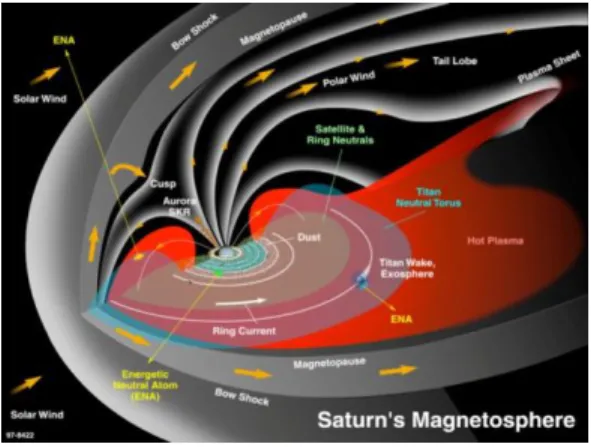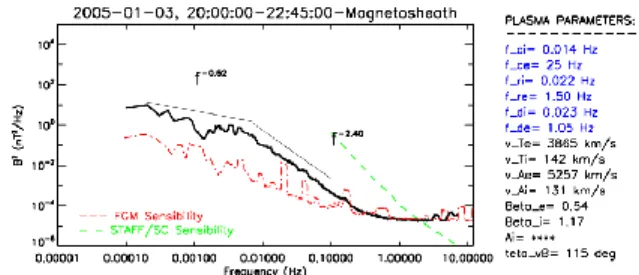HAL Id: hal-02860548
https://hal.archives-ouvertes.fr/hal-02860548
Submitted on 28 Sep 2020
HAL is a multi-disciplinary open access
archive for the deposit and dissemination of
sci-entific research documents, whether they are
pub-lished or not. The documents may come from
teaching and research institutions in France or
abroad, or from public or private research centers.
L’archive ouverte pluridisciplinaire HAL, est
destinée au dépôt et à la diffusion de documents
scientifiques de niveau recherche, publiés ou non,
émanant des établissements d’enseignement et de
recherche français ou étrangers, des laboratoires
publics ou privés.
In Situ Cassini Spacecraft Observations of Turbulence in
Saturn’s Magnetosheath
L. Z. Hadid, Fouad Sahraoui, Alessandro Retinò, Ronan Modolo, Patrick
Canu, C. M. Jackman, A. Masters, M. K. Dougherty, D. A. Gurnett
To cite this version:
L. Z. Hadid, Fouad Sahraoui, Alessandro Retinò, Ronan Modolo, Patrick Canu, et al.. In Situ
Cassini Spacecraft Observations of Turbulence in Saturn’s Magnetosheath. European Planetary
Sci-ence Congress 2013, 2013, London, United Kingdom. 8, pp.EPSC2013-1056, 2013, EPSC Abstracts.
�hal-02860548�
In Situ Cassini Spacecraft Observations of
Turbulence in Saturn’s
Magnetosheath
L.Hadid(1), F.Sahraoui(1), A.Retinò(1), R. Modolo (2), P.Canu(1), C. Jackman (3), A. Masters (4), M. K. Dougherty (5), D. A. Gurnett (6)
(1) Laboratoire de Physique des Plasmas, CNRS-Ecole Polytechnique-UPMC-Université Paris Sud, Palaiseau, France (2) LATMOS, CNRS-UVSQ-UPMCS, Guyancourt, France
(3) Department of Physics and Astronomy, UCL, London, UK (4) ISAS-JAXA, Sagamihara, Japan
(5) Deprtment of Physics, Imperial College, London, UK
(6) Department of Physics and Astronomy, University of Iowa, Iowa City, USA (lina.hadid@lpp.polytechnique.fr)
Abstract
Throughout this work we investigate, the properties ofturbulence in the Magnetosheath of Saturn. To do so, we computed Power Spectral Densities (PSD) based on Cassini interplanetary magnetic field data between 2004 and 2007. As a preliminary result, we show the absence of the Kolmogorov scale ~ f-5/3 in the inertial
range whereas only the f-1 scale is present.
1. Introduction
Turbulence is one of the most important yet not fully understood topics of modern physics (as pointed out e.g. by R. Feynman R [1] who defines it as "the most important unsolved problem of classical physics"). Understanding turbulence is crucial for ordinary fluids as well as for plasmas, where the electromagnetic interactions between charged particles make the physics even more complicated. Turbulence plays a major role in the energy and heat transport in plasmas. Among others, one key open issue of plasma turbulence is how the energy associated to magnetic and electric fields is converted and eventually dissipated into kinetic and internal energy (heat) of plasma. For most of space plasmas, such as those in the solar system, collisions between charged particles are negligible (due to the very low density) and all dissipation mechanisms are mediated by electromagnetic waves. One example of collisionless plasma is the interplanetary space (solar wind) where the mean free path of the particles is around 1 A.U.
1.1 Purpose of the study
The main goal of this work is to investigate the characteristics of the turbulence in the magnetosheath of Saturn (the region downstream of the planetary bow shock)
by using CASSINI spacecraft data
(http://saturn.jpl.nasa.gov/) and compare them to the features of plasma turbulence around the Earth. This can help us to have a better understanding of turbulence, considering that boundary conditions and plasma properties at the two planets are different.
Figure 1: Cartoon of Saturn’s magnetosphere. Adopted from jpl.nasa.gov.
2. Method and instruments
The first part of this work involves the data analysis and the computation of power spectra density (PSD), using the Windowed Fourier Transformation. One part of the dataset used throughout this study, which corresponds to the passage of Cassini in the magnetosheath, was taken from a list of 17 bow shock crossings (Dougherty et al. 2005 , [2]) and another part was extracted from a set of 94 crossings made between 2005 and 2007 (Masters et al. 2011, [3]). The fluxgate magnetometer sensor of the Cassini dual-technique magnetometer (MAG) provided the DC measurements of the amplitude and the direction of the magnetic field (Dougherty 2004 [4]). The Radio and Plasma Wave Science package (RPWS) provided continuous measurements of electric and magnetic field spectra (computed onboard) in the frequency bands [1-26 Hz] (Low Frequency Receiver – LFR) and [24 Hz – 12 kHz] (Medium Frequency Receiver – MFR), as well as snapshots of waveforms in two frequency bands of either [1Hz, 26 Hz] or [3Hz, 2.5 kHz] (Gurnett et al. 2004, [5]). Using the data collected by the ELectron Spectrometer (ELS) and the Ion Mass Spectrometer (IMS) sensors of the CAssini Plasma Spectrometer (CAPS) [Young et al. 2004, [6]) we could have access to the electons and protons moments respectively, and hence we could calculated most
EPSC Abstracts
Vol. 8, EPSC2013-1056, 2013
European Planetary Science Congress 2013 c
of the basic plasma parameters. One main limitation of particle datacomes from the fact that Cassini is three-axis stabilized spacecraft (not spinning) which prevents particle instruments in a full 360 view. Therefore, particle moments can be sometimes computed when the magnetosheath flow direction is not in the field of view of the CAPS instrument, resulting in incorrect moments. For a few cases, we have verified the goodness of moments by inspecting the counts in different sectors of the IMS detector.
Despite of these (and other) instrumental limitations with respect to data in near-Earth solar wind (e.g. Cluster ), there are several advantages of using Cassini data. One of the prominent benefits arisse from the fact that the density and the magnetic field are smaller than around Earth, hence the electron and ion gyrofrequencies (f_ci, & f_ce respectively ) are lower than those at Earth. These could be shown in the PSDs where the Ion & Electron scales are shifted to lower frequencies. Therefore we could study kinetic scales (ion scales and a part of electron scales) by using MAG data only (see figure 2). This is not possible around Earth, e.g. by using Cluster data, where both DC and AC magnetometers are required to study kinetic scales of turbulence. Also with Cassini data we can explore a different region of parameters space, since quantities such as Mach number, plasma beta etc. are different in Saturn’s magnetosheath.
3. Observations & results
Figures 2 & 3 show the PSDs calculated for different time intervals at different dates. Concerning the first part of the spectra, which corresponds to the low frequencies (up to 1 Hz), the results didn’t show the presence of the Kolmogorov scale ~ f-5/3 typically observed in the solar wind and the Earth’s magnetosheath (inertial range), but only the f-1 scale appeared instead. A statistical study is still in progress in order to reveal the presence of the f-1 at high frequencies, and the appearance or not of the Kolmogorov scale ~ f-5/3 in the magnetosheath of Saturn.
Figure 2: Two examples showing the Power density spectra of Cassini in the Magnetosheath where only f-1 scale appears, and no Kolmogorov scale ~ f-5/3 is present. The plasma parameters were calculated by using the CAPS instrument.
We also show higher order statistical moments of turbulent fluctuations (structure functions), to reveal the self-similar or intermittent property of the turbulence.
4. Summary and Conclusions
Using the data from Cassini spacecraft, we studied the caracteristics and properties of turbulence in the magnetosheath of Saturn. Despite of same limitations of Cassini intruments with respect to spacecraft in near-Earth space (e.g. Cluster). Cassini data allow to obtain interesting results on spectral properties of turbulence, since electron and ion scales are smaller and thus can be more easily studied. Also we can explore a different region of parameters space, since quantities such as Mach number, plasma beta etc. are different in Saturn’s magnetosheath. We preliminary find the absence of the Kolmogorov scale ~ f-5/3 in the inertial range whereas only the f-1 scale seems to be present.
References
[1] Feynman R., Leighton R. B., Sands M. (1964) The Feynman lectures on physics (Addison-Wesley, Boston, MA)
[2] M.K Dougherty et al. ‘’Cassini Magnetometer Observations During Saturn Orbit Insertion’’, Science, 307, 1266. (2005)
[3] A. Masters et al. ‘’Electron heating at Saturn’s bow shock’’, JGR, vol. 116, A10107, (2011)
[4] M.K Dougherty et al. “ The Cassini Magnetic field investigation’’, Space Sci. Rev. 114, 331 (2004)
[5]D.A. Gurnett et al. ‘’The Cassini Radio and Plasma wave investigation’’, Space Sci. Rev. Vol. 114, Issue 1-4, pp 395-463 (2004)
[6] Young et al. ‘’Cassini Plasma Spectrometer
Investigation’’, Space Sci. Rev. Vol. 114, Issue 4, pp 1-112 (2004)

